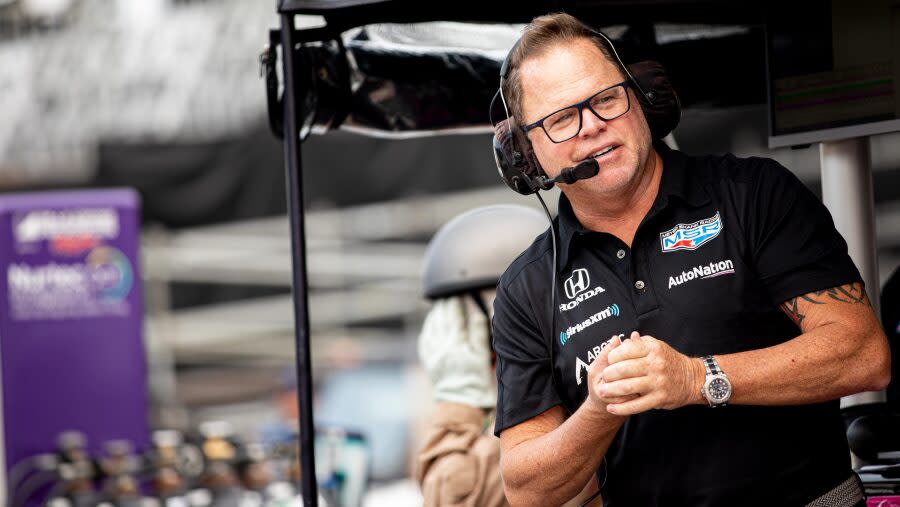MADISON, Illinois – As the NTT IndyCar Series returns from a three-weekend break because of the Olympic Games, the general topic of conversation remains frustration over the added weight of the hybrid engine having a negative impact on the racing product.
The current hybrid device adds 100 pounds to the IndyCar chassis and currently does not increase the horsepower to make a noticeable improvement for the additional weight.
The hybrid engine was delayed by a half season, finally made its competitive debut in the July 7 Honda Indy 200 at Mid-Ohio and had minimal impact on the race, other than discharging completely on Scott Dixon’s Honda on the parade lap of the race. That sent the championship hopeful back to the garage area where it was recharged, and he joined the race after it was well underway.
At the Hy-Vee IndyCar Race Weekend at Iowa Speedway, the short-oval contest featured far less passing than the wild, free-for-alls in past seasons. That led second-place finisher and current IndyCar Series points leader Alex Palou to say, “It’s the most boring thing I’ve ever done. It’s a shame we didn’t put on a better show. I’m sure everybody would agree it was a very boring show.”
Arrow McLaren’s Pato O’Ward called it a “snoozefest.”
Part of the problem at Iowa, however, was a pavement issue for the NASCAR Cup Series race in June. The lower lanes of that track were paved while the upper lane remained the old pavement, forcing the drivers to fight for the high line and stay there for most of the race.
Since that time, IndyCar had a fairly decent street race at Toronto on July 21 that was won by Colton Herta before taking the next three weekends off to accommodate television partner NBC’s coverage of the Olympic Games in Paris, France.
But as the IndyCar Series rolled the cars off the trailers on Friday, and hit the track in the morning at the 1.25-mile World Wide Technology Raceway across the Mississippi River from the Gateway Arch in St. Louis, team owners, engineers and drivers were expecting a “follow-the-leader” contest in Saturday’s Bommarito Automotive Group 500.

“As we sit here today in the aero configuration, we’re going to run, with zero tire degradation, which means once you get rolling, you kind of are where you are, it’s going to be really, really hard to pass,” IndyCar team owner Michael Shank told NBCSports.com during an interview for the Pit Pass Indy podcast. “Now, I’ve heard people tell me that in the past and we actually ended up passing. So, I guess we’ll see.
“But when you have a zero deg tire on a track, and the only passing that will happen is during pit-stop exchanges, that’s what I’m afraid of.
“So, let’s see if I’m wrong and we’ll go from there.”
Part of the problem is the Indy cars are heavier than before and the tires that are being used at the track are a harder compound to handle the added weight and load of the race cars.
“I think they’re still working on trying to figure some of that out,” Shank said. “To be honest, I don’t think we’re done.
“I think there’s more options to look. We’ve got a bigger map and different weight distributions. But the competition is so close now, it’s really hard to get off of each other.
“I’m going to leave that to most of the engineers out there. I don’t totally know the answer to that. If it’s a combination of tire compounding or downforce, downforce and compounding that we just haven’t hit yet on an oval specifically.
“I don’t know that, but I’m assuming that the resolution will be somewhere in the middle.”
Shank believes the only way to solve the issue will be with a completely new car. IndyCar is currently using the same Dallara DW-12 that began competition in 2012, but team owners and other key team principals believe IndyCar is well underway toward designing a new car over the next couple of seasons.
Meantime, the drivers and teams have to deal with the extra 100 pounds and the modest boost in horsepower that the hybrid engine generates.
An impactful solution probably won’t be in place before the end of the season, the Big Machine Music City Grand Prix at Nashville Superspeedway on September 15.
But one of IndyCar’s most experienced and respected drivers said Friday at World Wide Technology Raceway not to give up hope on the potential of the hybrid power unit.
“I wouldn’t get your hopes up, but as I urge all of you to be positive about, is what we are in the midst of,” Graham Rahal said Friday after his qualification attempt for the Bommarito Automotive Group 500. “This isn’t like a lot of other sports where they can practice behind closed doors, everything we are experiencing, you guys see it and are living it with us.
“Unfortunately, you are talking about a car that has a lot more mass. You are talking about a car with a different engine unit with the hybrid. That can’t be understated.”
The hybrid pulls away power from the engine but adds it to the electrification. But on a short oval like WWTR, the engine doesn’t get as much of a bump from the electrification as much as a slow corner on a road course.
For IndyCar’s tire manufacturer at Firestone, it has elected to use a harder compound tire for safety. But the harder compound also doesn’t degrade, taking away from one of the key elements to creates a competitive race.
“I know everybody is frustrated with what they are seeing right now,” Rahal said. “My hopes are with time; we will get there.
“The downside is you are going to get this show four of the next five races and that is a bummer.
“But hopefully, magic will strike, and it will be all right.”
Rahal said it will take a lot more testing and more electrical energy will have to be created from the hybrid system.
“How much power can we get out of the hybrid?” Rahal asked. “A place like this, you don’t even feel it. It feels ineffective. We need to figure out how to get more out of it at a place like this. But when you have the downforce, you have here, you don’t get the auto regeneration to utilize the full battery charge.
“There is a lot that goes into this, a lot for everybody to think about, but we are living it live on air, and that is a little tough.”
Rahal believes anything can still happen in the race itself and it could be an entertaining show. But in a paddock filled with predictions of single-file racing, Rahal’s comments prove he has hope in the hybrid engine concept and why it is important to the engine manufacturers at Honda and Chevrolet to stay true to IndyCar’s course.
The return to racing also brought some changes in the cockpit.


Agustin Canapino was released from IndyCar’s Juncos Hollinger Racing Team on August 7, ending a short, but extremely tumultuous term involving the driver from Argentina.
He was replaced by IndyCar veteran Conor Daly, who was announced on Tuesday and will drive the final five races in the No. 78 Chevrolet on the team owned by Argentina’s Ricardo Juncos and Brad Hollinger.
“It’s been chaotic this year,” Daly said Wednesday. “There’s been not a ton of races, but really good moments from the 500 to Xfinity race at Indy. There’s been a lot of times where I’ve actually had a big smile on my face this year, which is nice.
“This kind of I think restores that same smile because it’s a great chance to just go racing in a field that I love to be a part of, but also love to be competitive in. Yeah, it will be a lot of work for sure. That’s what racing is all about, putting in the work.
“Yeah, I’m excited to do it.”


David Malukas, who began the year with Arrow McLaren but dislocated his left wrist in a mountain biking crash in February and was ultimately terminated from the team on April 29, signed a multi-year contract to drive for AJ Foyt Racing on Tuesday.
That contract begins in 2025.
After he was released from Arrow McLaren, Malukas replaced Tom Blomqvist at Meyer Shank Racing beginning with the June 23 Firestone Grand Prix of Monterey at Laguna Seca.
Malukas finished sixth in the July 21 Ontario Honda Dealers Indy Toronto in the No. 66 Honda and was the third fastest qualifier on Friday at WWTR for Saturday night’s race.
“We had a few options, but Foyt’s success on the ovals, especially at the Indianapolis 500, to me it seemed like a pretty clear choice,” Malukas said. “The alliance with Team Penske has helped both sides and I think it will be great coming from MSR and its alliance with Andretti Global to see how other teams do it.
“Overall, things have been good with Mike Shank and talks started a few weeks ago. There have been disappointments on both sides, but in the end, we move on and look forward to next season.”
Driver changes only added to the intrigue of IndyCar returning to action this week. But the overwhelming storyline continues to be how the hybrid engine will impact the end of the season, especially on the short ovals.
At least Rahal has hope that one day, the hybrid will reach its full potential and become a valuable tool to the drivers.
For others, that day can’t come fast enough.
Follow Bruce Martin on Twitter at @BruceMartin_500
Source Agencies


